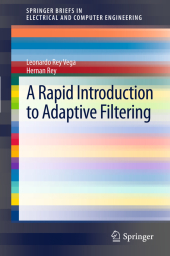 Neuerscheinungen 2012Stand: 2020-01-07 |
Schnellsuche
ISBN/Stichwort/Autor
|
Herderstraße 10
10625 Berlin
Tel.: 030 315 714 16
Fax 030 315 714 14
info@buchspektrum.de |

Hernan Rey, Leonardo Rey Vega
(Beteiligte)
A Rapid Introduction to Adaptive Filtering
2013. 2012. xii, 122 S. 23 SW-Abb. 235 mm
Verlag/Jahr: SPRINGER, BERLIN 2012
ISBN: 3-642-30298-X (364230298X)
Neue ISBN: 978-3-642-30298-5 (9783642302985)
Preis und Lieferzeit: Bitte klicken
In this book, the authors provide insights into the basics of adaptive filtering, which are particularly useful for students taking their first steps into this field. They start by studying the problem of minimum mean-square-error filtering, i.e., Wiener filtering. Then, they analyze iterative methods for solving the optimization problem, e.g., the Method of Steepest Descent. By proposing stochastic approximations, several basic adaptive algorithms are derived, including Least Mean Squares (LMS), Normalized Least Mean Squares (NLMS) and Sign-error algorithms. The authors provide a general framework to study the stability and steady-state performance of these algorithms. The affine Projection Algorithm (APA) which provides faster convergence at the expense of computational complexity (although fast implementations can be used) is also presented. In addition, the Least Squares (LS) method and its recursive version (RLS), including fast implementations are discussed. The book closes with the discussion of several topics of interest in the adaptive filtering field.
Wiener Filtering and examples.- Steepest descent procedure.- Stochastic gradient adaptive filtering: LMS (Least Mean Squares), NLMS (Normalized Mean Squares).- Sign-error algorithm, APA (Affine Projection Algorithms).- Convergence results.- Applications.- LS (Least Squares) and RLS (Recursive Least Squares).- Computational complexity and fast implementations.- Applications.
From the reviews:
"Digital signal processing (DSP) is a popular course for undergraduate students in electrical and communications engineering. ... This book can be read in a few days. The book has six chapters, including a chapter each for an introduction and advanced topics. The presentation is easy to read and understandable, and the authors provide both theoretical and mathematical treatments of the material. ... The book could also serve well as a quick reference for engineers and students who are developing DSP solutions." (S. Ramakrishnan, ACM Computing Reviews, December, 2012)


